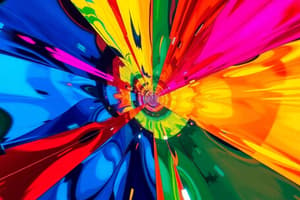Podcast
Questions and Answers
What does the law of reflection state?
What does the law of reflection state?
- The angle of incidence equals the angle of reflection. (correct)
- The angle of incidence is always zero.
- The angle of incidence is less than the angle of reflection.
- The angle of reflection can vary with surface texture.
What type of image is produced by a concave mirror when the object is placed inside the focal point?
What type of image is produced by a concave mirror when the object is placed inside the focal point?
- An inverted and enlarged image
- A real image
- A virtual image (correct)
- No image at all
Which type of reflection occurs on smooth surfaces and produces clear images?
Which type of reflection occurs on smooth surfaces and produces clear images?
- Diffused reflection
- Scattered reflection
- Angular reflection
- Specular reflection (correct)
What characteristic is true for virtual images formed by mirrors?
What characteristic is true for virtual images formed by mirrors?
What type of mirror always produces virtual images that are smaller than the object?
What type of mirror always produces virtual images that are smaller than the object?
In a flat mirror, how does the size of the image compare to the size of the object?
In a flat mirror, how does the size of the image compare to the size of the object?
Flashcards are hidden until you start studying
Study Notes
Light Reflection
Law of Reflection
- States that the angle of incidence equals the angle of reflection.
- Measured from a normal line (perpendicular to the surface at the point of incidence).
- Formula: θi = θr, where θi is the angle of incidence and θr is the angle of reflection.
Reflection in Mirrors
- Flat Mirrors: Produce virtual images that are the same size as the object and laterally inverted.
- Curved Mirrors:
- Concave Mirrors: Can produce real or virtual images depending on the object's distance from the mirror.
- Real images: Formed when the object is outside the focal point.
- Virtual images: Formed when the object is inside the focal point.
- Convex Mirrors: Always produce virtual images that are smaller than the object and upright.
- Concave Mirrors: Can produce real or virtual images depending on the object's distance from the mirror.
Types of Reflection
-
Specular Reflection:
- Occurs on smooth surfaces.
- Produces clear and defined images.
- Example: Reflection on a calm water surface or glass.
-
Diffuse Reflection:
- Occurs on rough surfaces.
- Scatters light in many directions.
- Does not produce a clear image.
- Example: Reflection from a wall or paper.
Reflection and Images
- Virtual Images: Formed by the apparent intersection of light rays; cannot be projected on a screen.
- Real Images: Formed by the actual intersection of light rays; can be projected on a screen.
- Image characteristics in mirrors:
- Size: Same size in flat mirrors; varies in curved mirrors.
- Orientation: Inverted in real images; upright in virtual images.
- Distance: Depends on the object distance from the mirror.
Light Reflection
Law of Reflection
- The angle of incidence is equal to the angle of reflection.
- Measurements are taken from a normal line, which is perpendicular to the surface at the point of incidence.
- The relationship is expressed by the formula: θi = θr.
Reflection in Mirrors
- Flat Mirrors: Generate virtual images that are identical in size to the object and appear laterally inverted.
- Curved Mirrors:
- Concave Mirrors: Capable of producing both real and virtual images depending on the distance of the object from the mirror.
- Real images are formed when the object is situated outside the focal point.
- Virtual images are generated when the object is within the focal point.
- Convex Mirrors: Always yield virtual images that are smaller than the object and remain upright.
- Concave Mirrors: Capable of producing both real and virtual images depending on the distance of the object from the mirror.
Types of Reflection
- Specular Reflection:
- Happens on smooth surfaces.
- Produces sharp and clear images.
- Commonly observed on surfaces like calm water or glass.
- Diffuse Reflection:
- Takes place on rough surfaces.
- Light is scattered in multiple directions.
- Does not create a defined image.
- Example includes reflections from walls or paper.
Reflection and Images
- Virtual Images: Result from the apparent intersection of light rays; these images cannot be projected onto a screen.
- Real Images: Formed by the actual convergence of light rays; these images can be projected onto a screen.
- Characteristics of images in mirrors include:
- Size: Constant in flat mirrors; variable in curved mirrors.
- Orientation: Inverted for real images; upright for virtual images.
- Distance: Relies on the object's distance from the mirror.
Studying That Suits You
Use AI to generate personalized quizzes and flashcards to suit your learning preferences.




